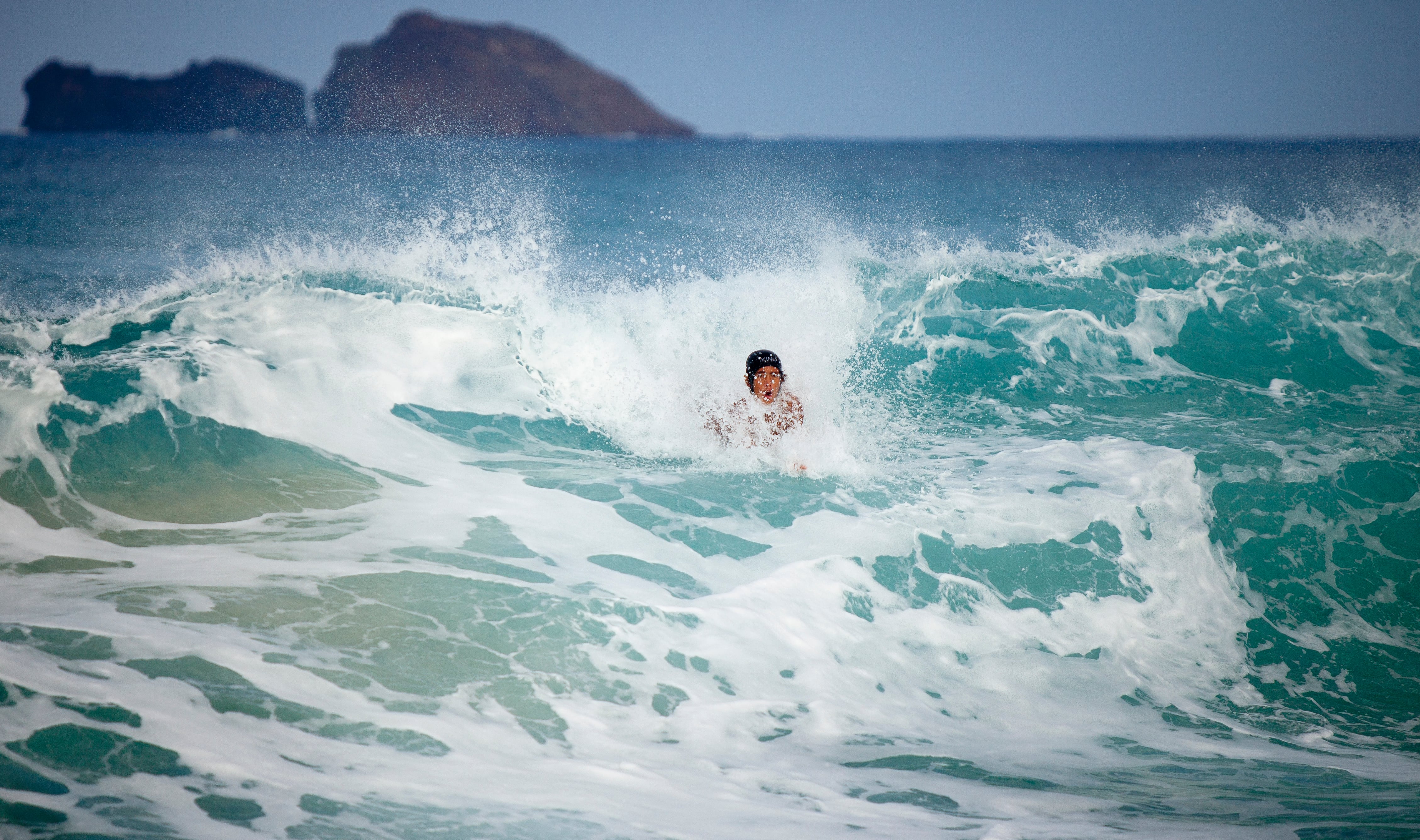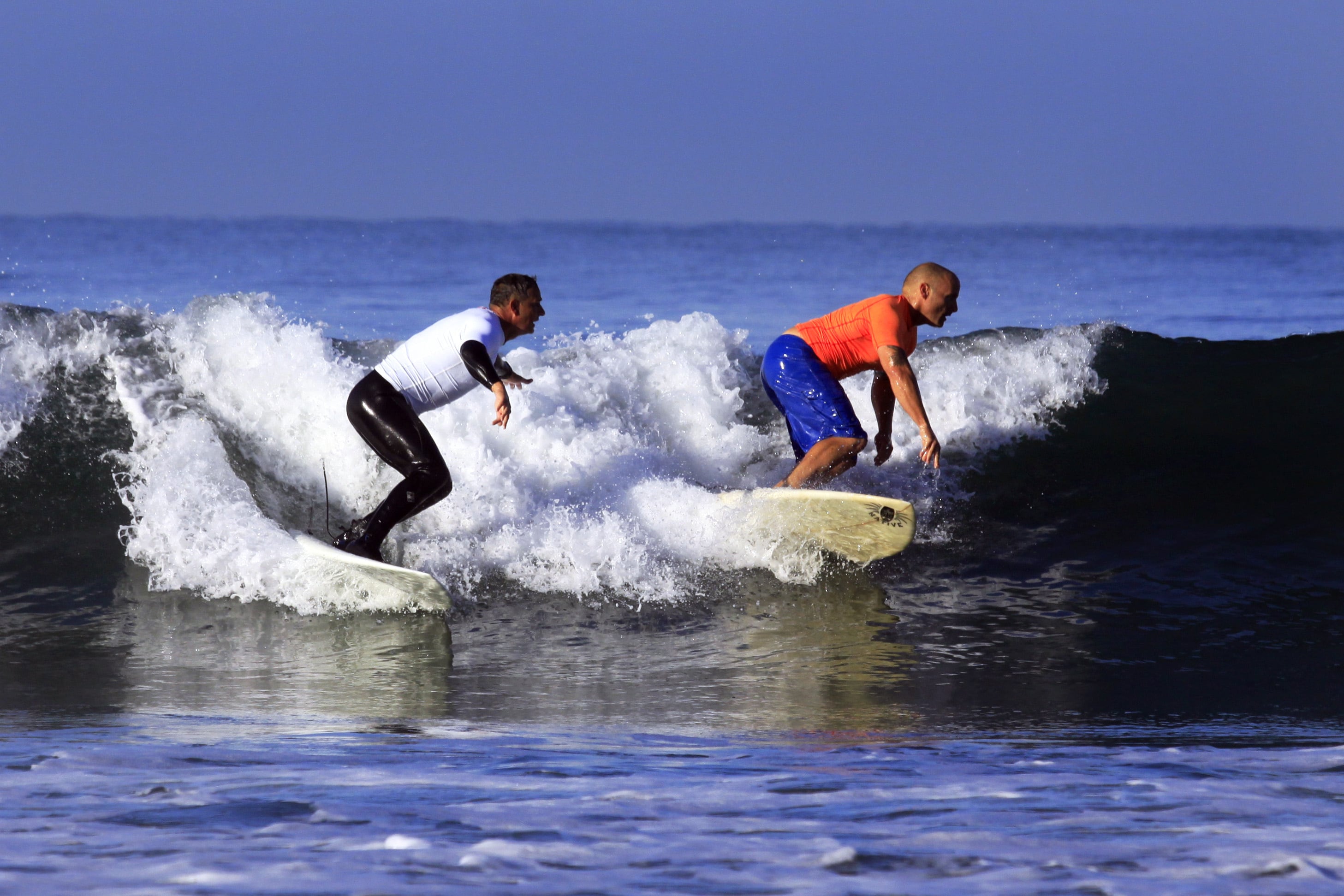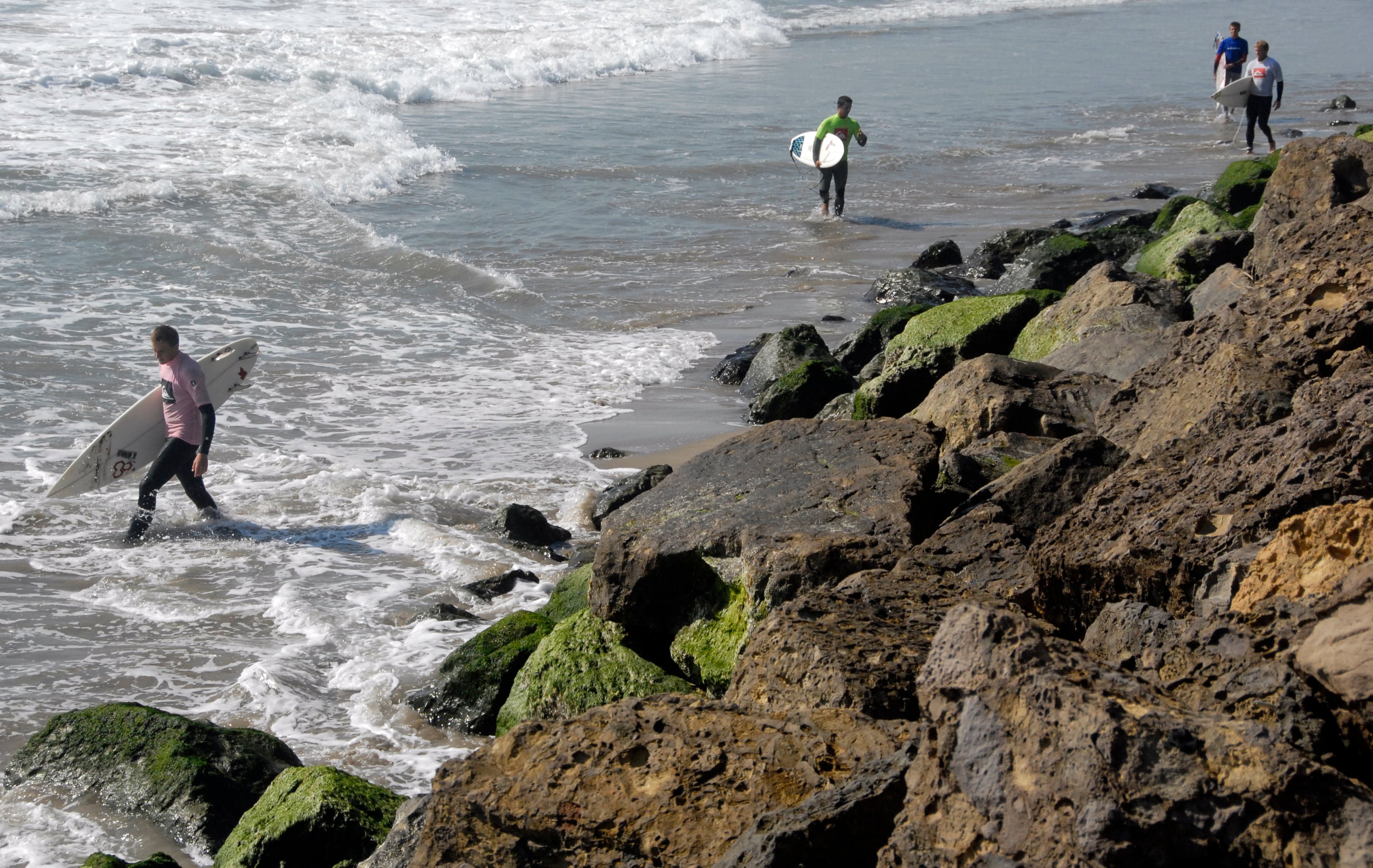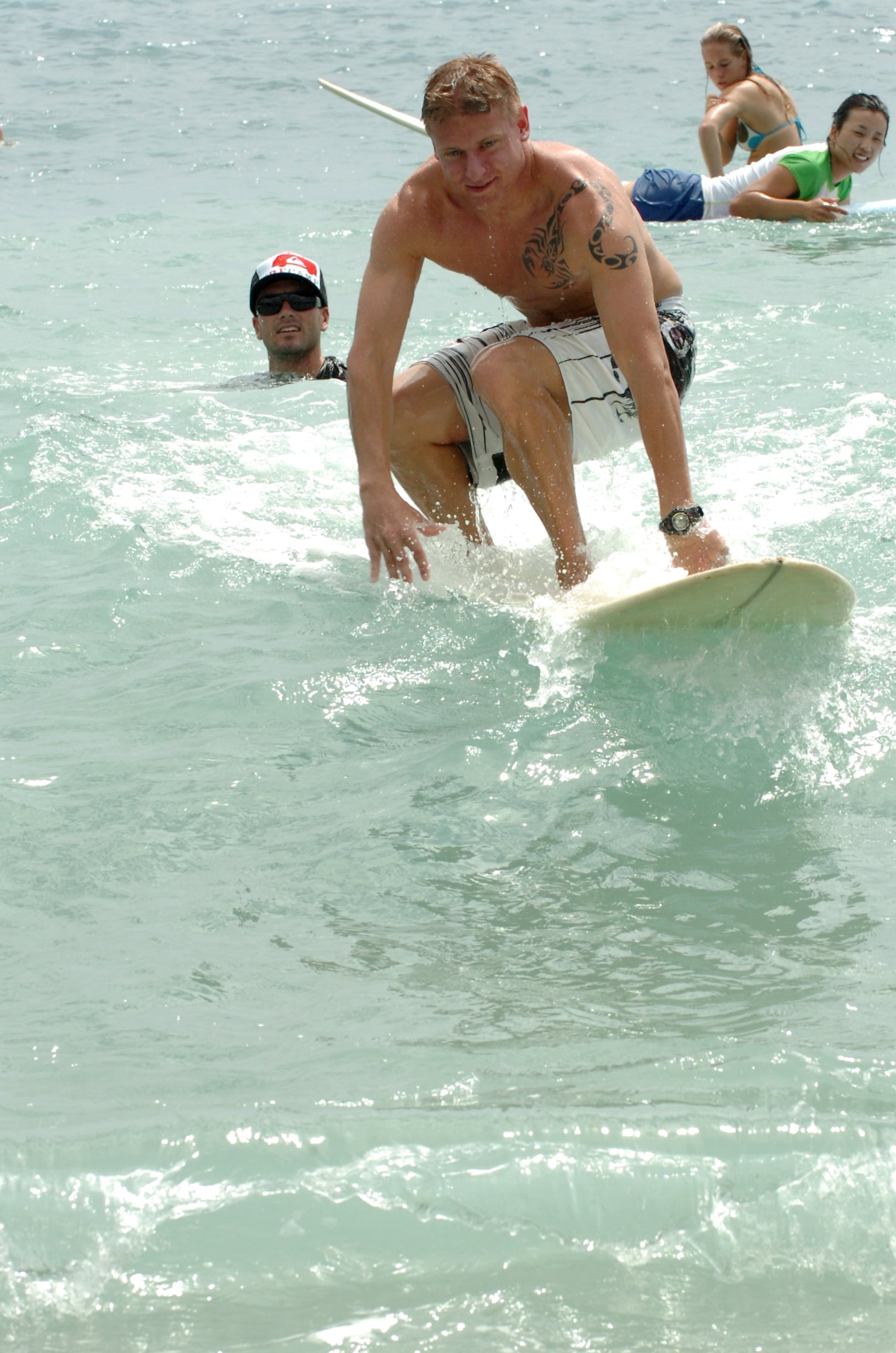Whether you're an old salt long-boarder or an eager newbie looking to surf for the first time, the military commands some prime beachfront property that's perfect for wave catchers of all stripes.
Here's our guide to some of the best military-only beaches and secret spots to get your surf on.
HAWAII
Marine Corps Base Hawaii: On the eastern side of Oahu on Kaneohe Bay, Marine Corps Base Hawaii offers two prime surfing beaches.
Pyramid Rock, named after the angular rock jutting above the powder-white coastline and considered one of Hawaii's best-kept surfing secrets, offers a consistent 6- to 10-foot-tall shore break. "It can get pretty heavy there," says Marine Corps Master Sgt. Eric Franklin. "When it's really coming in, it breaks hard, but they're fun waves, too."
Meanwhile, "Officers Breach" — named for its proximity to officer housing, not because it's brass-only — enjoys similar swells. "There's a little park there where you can park and walk down the beach," Franklin says.

A body surfer competes in the 2015 Pyramid Rock Body Surfing Competition in February. The competition is held annually by Marine Corps Community Services, Hawaii (MCCS) and is open to all civilians and military members.
Photo Credit: Photo: Lance Cpl. Julian Temblador/Marine Corps
Joint Base Pearl Harbor-Hickam: Escape the Waikiki crowds at Hickam Beach, considered a great place to learn the basics of surfing. The base's morale, welfare and recreation office runs a surf shack with board rentals and instructors who will help you with the basics. When the surf is low, you can watch the planes take off and land on the airstrip that juts out in the water nearby.
Coast Guard Air Station Barbers Point: With tamer waves, White Plains Beach is another solid spot to learn how to surf in Hawaii. MWR offers board rentals and regular surfing classes. A one-hour session is $35 per person. You can also rent up to three-bedroom cottages right on the beach.
Barking Sands Pacific Missile Range Facility: On the island of Kauai's western shore, Barking Sands' Majors Bay beach boasts solid crowd-free surfing opportunities with onsite showers and parking as well as cottage rentals for longer stays. Shenanigans, the base's on-the-beach bar and grill, will keep you fueled and offers the perfect view to watch the sunset.
The Outdoor Adventure Center rents surfboards as well as boogie boards, kayaks, camping equipment other beach essentials.
VIRGINIA
Dam Neck Annex: When it comes to surfing, forget Virginia Beach. There's something much better in the water at the Dam Neck Annex of Naval Air Station Oceana, just 20 minutes south of all those crowds.
The home of SEAL Team 6, Dam Neck sports more than three miles of oceanfront with more than 1,100 acres of highlands, coastal beaches and sand dunes.
"This is one of those great places to escape the crowds of Virginia Beach," says U.S. Surfing Federation president Paul West. "Virginia Beach is one of the most crowded beaches to surf you'll ever see, and honestly the surfing is not that great, but at Dam Neck there will be maybe a dozen guys surfing. And it's actually a great spot for beginners to intermediate surfers."
Oceanside cottage rentals make getting to the surf zone easy, and the base also offers surfboard and paddleboard rentals.
FLORIDA
Naval Station Mayport: Just outside Jacksonville, Mayport boasts a long swath of surfing access. That starts on a beach section affectionately knows at "The Poles" for the big wooden markers that march into the sea delineating the Navy base from the public beach at Hannah Park.
"Those poles mean the difference between fighting for waves with a thousand other guys — it's ridiculous — and enjoying more than a mile-and-a-half of beach with maybe 20 to 30 other surfers," West says.
"There's three or four good, solid breaks as you move north from the Poles," says Coast Guard Petty Officer 1st Class Brian Antel, who runs the Mil-Surf.com website dedicated to the military surfing community. Not far up, there's an old lighthouse he likes to use as a marker. "If you line yourself up with that lighthouse, you'll usually get some great breaks," he says.
On the far north end of Mayport's beach is an area know as the Jetties, "which is popular with wind surfers because it gets pretty smooth, but can also be a great place for surfing," says Antel.
Patrick Air Force Base: Just south of Cocoa Beach, "the surfing is very good here with some of the most consistent waves you'll find," says West. Typically, those waves tend to stay under three feet, but when the weather kicks in, it can create walls of water more than 10 feet high.
Florida's Scenic Highway A1A runs right through the base. "We name the beaches there based on what turnoff you take. So, some of the best breaks are at Picnic Table, and Second Light Beach has parking for about 20 cars."
Stay at the Space Coast Inn on the north end of the base and just a few blocks from the beach.
Coast Guard Station Ponce Inlet: Just south of Daytona Beach next to Symrna Dunes Park, "this place gets great waves," Antel says.
CALIFORNIA

Col. Paul Miller with Headquarters and Support Battalion, Marine Corps Installations West, left, and Norm Norred with Assault Craft Unit 5 compete to see who can ride the wave longer during the 2013 USAA Commanding General's Surf Competition at San Onofre Beach on Camp Pendleton, California. After riding a total of six waves, the top two waves are taken for each competitor's score.
Photo Credit: Cpl. Michael Iams/Marine Corps
Camp Pendleton: About 40 miles north of San Diego, the Marine Corps' biggest base on the West Coast sports more than 17 miles of largely pristine beachfront property.
Just up from San Onofre State Beach, Churches Beach is among Marine Master Sgt. Eric Frankin's favorites. "The waves come in and peel off to the right with these epic long rides. Over the Fourth of July weekend, I swear I was catching waves for 170 yards," says Franklin, who leads the Pendleton Surf Club.
Just on the other side of Oceanside's harbor, the Del Mar Jetties is another favorite. Better known among the local military surfers as DMJs, this section offers more of a beach break that's "very hollow when the waves get big," Franklin says. "It just barrels over and it takes a lot more skill to finesse. You definitely need to know what you're doing or you're not going to have any fun."
And because it's separated by the harbor, there's no way for locals to paddle in, so the crowds are even thinner.
While open to the public, Lower Trestles beach is a 30-minute walk for surfers who don't have access to Camp Pendleton. "It's a fantastic wave, one of the best breaks in the world," says West. "It's a mile and half hike in for most people, but the military can just park and surf."
Of course, Camp Pendleton has discounted lodging, but if you want to stay close to the water, head to the military campground at San Onofre Beach.
Naval Base Ventura County: Just north of Los Angeles, the base is split between two installations — Point Mugu and Port Hueneme.
The Point Mugu part of the base "has great waves in the right conditions," Antel says. Indeed, regular surf contests have been staged there in recent years.

A group of surfers head out to the water at Point Mugu at Naval Base Ventura County, California, during the Naval Base Ventura County Surf Contest. More than 100 competitors took part in five classes.
Photo Credit: Petty Officer 1st Class Michael Moriatis/Navy
Point Mugu also hosts the military-run Beach Motel & RV Park, while on the Port Hueneme side, MWR's Outdoor Recreation office rents surfboards and other beach gear.
Vandenberg Air Force Base: The prime surf zone is dubbed Surf Beach, along with Wall and Minuteman Beaches. Near Santa Barbara, Vandenberg's beaches "get good and are usually very uncrowded," says Antel. That may be because of the sharks as much as anything else, though. There were three shark attacks last October, prompting base officials to shut down access for a few days.
Vandenberg hosts a FamCamp for RVs and tents about six miles from the beach.
CARIBBEAN
Coast Guard Air Station Borinquen, Puerto Rico: On the northern coast near Aguadilla, this station has "great facilities right by the ocean," says Antel. "You can stay in the lighthouse there, and there are several world-class surf breaks right in that area."
Guantanamo Bay, Cuba

A Joint Task Force Guantanamo trooper practices standing on his surfboard during a surf camp held at Naval Station Guantanamo Bay's Windmill Beach in 2008 while instructor and pro-surfer Skeeter Zimmerman (left) observes. The class was taught by Zimmerman and Matt Kechele, who demonstrated fundamentals and explained the dangers and hazards of surfing.
Photo Credit: Staff Sgt. Megan Burnham/Defense Department
Even as relations with Cuba thaw, this likely will remain one the most unusual surf spots in the military catalog. This much we know: the Taliban don't surf — especially here. But you can, if you happen to be passing through.
"Windmill beach has a good break right under Camp X-ray, a really unique spot," Antel says.





